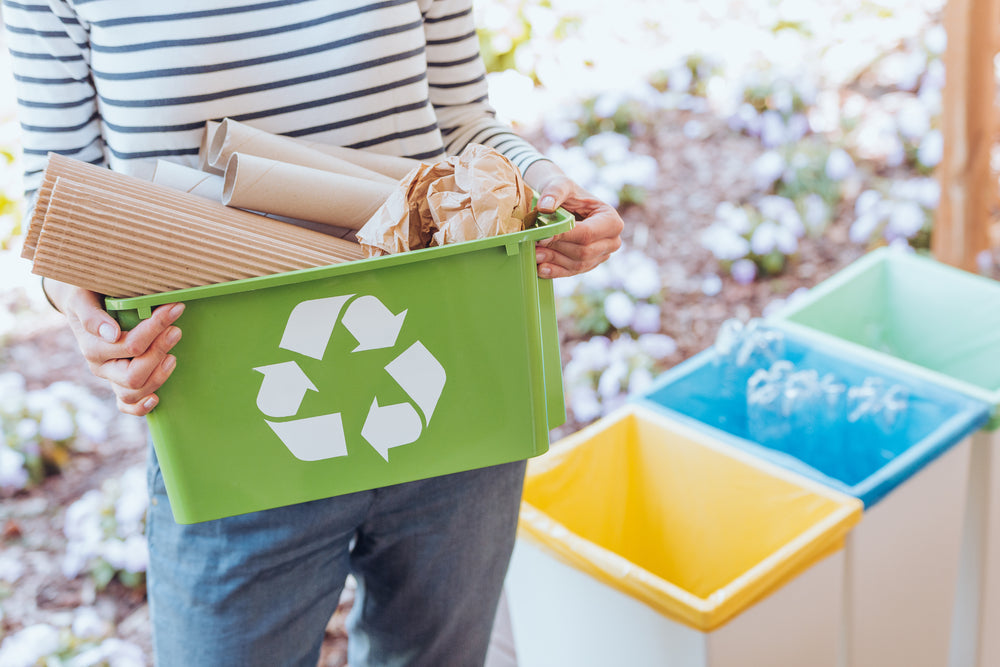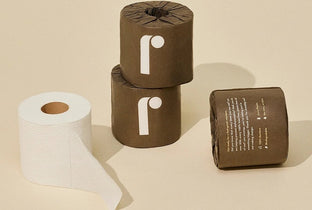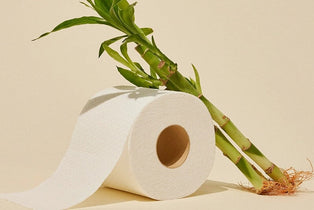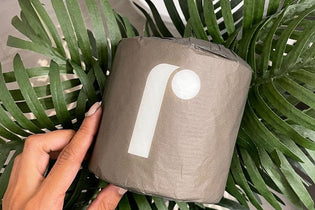
TLDR
When you consider all of the different types of paper products you encounter each day, it’s easy to understand why Americans have been known to discard over 67 million tons of paper and paperboard per year. From junk mail to dry cleaning receipts to the magazine you bought on impulse at the grocery store, we collect a lot of paper in a single day.
Fortunately, we’ve been able to help transform some of that waste paper into reusable resources such as recycled paper towels, which are made from recycled materials. In fact, paper products were the most recycled type of consumer waste in 2018, according to the Environmental Protection Agency.
If you’re interested in saving a few trees to preserve our planet’s natural resources, this guide has everything you need to know about how to recycle paper. Let’s dive in!
Paper Waste: What You Can and Can’t Recycle
So how is paper recycled? The paper recycling process is a complex process that begins the moment you sort your old newspapers, catalogs, and print paper into your recycling container. Once your recycling facility picks it up, it then requires three things:
- Heavy machinery
- Detailed chemical processing
- The coordinated efforts of many people, including you
From there, it gets turned into paper pulp, a raw material used to make new paper products. Fortunately, for the average consumer, recycling your waste paper at home is one of the easiest steps of the process. You can recycle a variety of paper products, including old newspapers, scrap paper, tissue paper, and small pieces of paper. You can also recycle paper bags, but plastic bags cannot be recycled with paper as they have a plastic coating.
That said, there can still be some confusion around exactly which kinds of paper can be recycled and which can’t. Toilet paper should not be recycled, but are toilet paper rolls recyclable? While it’s true that a majority of the paper products you use can go in your recycling bin, there are a few outliers that are better suited for the trash, the compost pile, or some clever upcycling. We’ve even figured out how to make recycled toilet paper to combat deforestation and additional waste!
6 Paper Products That You Can Recycle
In most cases, you should be able to recycle some of the most common paper products you use every day, like:
- Cardboard and paperboard packaging – In an age of heightened at-home deliveries, you’ll be glad to know that the cardboard box your goods came in is recyclable. Paperboard packaging, like cereal and pasta boxes, shoe boxes, and gift boxes can also go in the bin. Just make sure to remove any tape or stickers beforehand.
- Newspaper – If you can believe people still get physical newspapers, it’ll be good to know that newspapers are also incredibly recyclable. In fact, most newspapers can be recycled up to eight times. You can also recycle any inserts, like coupons or supplement publications.
- Phone books, magazines, and catalogs – From the yellow pages to the glossy pages of a magazine or catalog, feel free to put this out for collection when you’ve finished your morning read. Just be sure to remove any plastic wrapping or other non-paper add-ons beforehand.
- White office paper – Standard printer paper that you use in your home office can be recycled, even if it's been printed on. Staples and paper clips should be removed before recycling.
- Envelopes – From your utility bills to junk mail to credit card offers, most envelopes can be tossed in with the rest of your paper recyclables.
- Books – In most areas, you should be able to put paperback books in with the rest of your paper recycling. Some recycling agencies may also accept hardcover books, though not all. Check with your local agency before putting hardcover books in the recycling bin.

5 Paper Products That You Can’t Recycle
However, it’s best to find alternate uses for each paper material listed below (or throw them away altogether):
- Soiled paper – Paper that’s become soiled by contaminants like oil, grease, chemicals, and food waste cannot be recycled. That means no paper plates, pizza boxes, or grease-stained cardboard.
- Coated or treated paper – This includes paper that’s been laminated, covered in wax, and coated in foil. Butcher paper, parchment/wax paper, and similar paper types are not recyclable.
- Receipts – Generally speaking, it’s best to put your unneeded receipts in the trash. Most of them are printed on thermal paper containing a plastic compound called Bisphenol A, which cannot be recycled.
- Shredded paper – It’s a good idea to shred the personal documents you no longer need. However, paper fibers that are cut that short can’t be recycled. It’s best to find a way to reuse shredded paper, like using it as packing material or placing it in your kitty litter box.
- Paper towels, napkins, and tissue – These products are typically not durable enough to be at a recycling facility. Additionally, they’ve likely been soiled by contaminants, making them ineligible for reuse.
It’s important to remember that what you can and can’t recycle will also be influenced by where you live. Civic governments and individual recycling centers decide what’s allowed, so it’s best to check with your local officials or your recycling service provider. They’ll have the most accurate and up-to-date information.
How to Recycle Paper at Home
Now that you know what kinds of paper are recyclable, the hardest part is out of the way. When it comes to recycling your paper waste at home, there are only three more things you need to keep in mind:
- Separate your paper waste – While it isn’t necessary to separate your paper waste products from one another, you do need to separate them from your other recyclables, like glass and plastics.
- Keep it clean – Keeping your paper waste separate from your regular trash is the best way to ensure that it doesn’t become contaminated. As mentioned above, paper that’s been contaminated in any way cannot be recycled. Having a recycling bin that’s only for your paper waste is an easy way to make sure it stays clean and ready for the recycling center.
- Put it out on collection day – It’s important to know what day your recycling is collected. Depending on where you live and your recycling service, this may or may not be the same day as your garbage collection. Until then, keep your recycling inside to avoid environmental contaminants, like rain, which can make paper products ineligible for recycling.

What Happens After the Recycling Is Collected?
Once your recycling service comes to collect your recycling, they transport it to a materials recovery facility, or MRF, where the paper recycling process begins. The process involves several steps, including:
- Sorting and baling – Once the paper recycling arrives at the MRF, it’s sorted according to its paper type, whether it's a newspaper, cardboard, or magazine. Then, the sorted recycling is bundled into bales for transportation to the paper mill.
- Pulping – At the mill, a machine is mixes the paper waste with water and chemicals that break it down to pulp.
- Pressing, drying, and rolling – The pulp is pressed through a screen to clean the paper of contaminants like metals, plastics, and adhesive. Then, large rollers and heated metal rollers are used to press and dry the pulp matter. These rollers also help eliminate wrinkles and irregularities from the new paper.
Once the process is complete, the paper waste has been officially recycled. Then, it's rated according to its strength and grade before the facility sells it for reuse.
Why is Recycling Paper Important?
One of the advantages of recycling paper at home is knowing that you can take an active part in protecting the environment and the longevity of our planet’s resources.
As one of the largest kinds of consumer waste, paper products that don’t get recycled only clutter landfills, which takes up room that could be used for non-recyclable waste products. And with the United States facing a landfill shortage, freeing up as much extra land area as possible is crucial to our safety.
Beyond liberating limited landfill space, recycling paper products provides us with numerous other sustainability benefits, including:
- Saving energy – Making paper products from recycled materials uses far less energy than making new products from scratch. When you cut out the machines used for foresting, transporting, and producing new paper, you save a lot of energy.
- Reducing greenhouse gas emissions – One big perk of reducing energy use is that doing so also reduces the number of greenhouse gasses that are released into the atmosphere. This is because when recycled materials are used to make paper, there’s no need to extract materials from the earth, a process that releases greenhouse gasses.
- Conserving natural resources – You may not think about it, but producing new paper goods puts a tremendous strain on valuable natural resources that are not renewable, like water and trees. It’s estimated that every ton of paper that’s produced is equal to about 17 trees and 7,000 gallons of water.
Reel Paper: The Environmentally Friendly Option
These days, it’s important that we all do what we can to limit our reliance on natural resources, curb our energy use and waste emissions, and make smart, sustainable choices in every aspect of our lives. Recycling your paper products is just one way to give back to the planet.
But, you may also want to invest in sustainable paper alternatives. That’s where Reel Paper comes in.
Our tree-free paper products are made from 100% recycled paper or bamboo. Free of inks, dyes, BPAs, and plastics, they’re 100% biodegradable and 100% soft. They’re also conveniently shipped to your door in a 100% recyclable, eco-friendly box.
And when you join the Reel movement, you don’t just get recycled paper products. You also support us in our mission to improve lives around the globe by providing access to clean toilets.
The time to start living more sustainably is now.
Sources:
Environmental Protection Agency. Paper and Paperboard: Material Specific Data. https://www.epa.gov/facts-and-figures-about-materials-waste-and-recycling/paper-and-paperboard-material-specific-data
Illinois Department of Central Management Services. Recycling 101. https://www2.illinois.gov/cms/agency/recycling/i-cycle/Pages/cycle101.aspx#
Earth 911. How to Recycle Phone Books. https://earth911.com/recycling-guide/how-to-recycle-phone-books/#
University of Illinois. Recycling Myths. https://publish.illinois.edu/bin-it-recycling/recycling-myths/#sthash.xmjuVtGq.dpbs
Global Citizen. Where Will the Trash Go When All the US Landfills Are Full? https://www.globalcitizen.org/en/content/us-landfills-are-filling-up/
Recycling.com. Paper Recycling – How to Recycle Paper at Home. https://www.recycling.com/paper-recycling/
Green Matters. Why is It Important to Recycle? https://www.greenmatters.com/p/why-is-it-important-to-recycle
American Progress. Energy from Waste Can Help Curb Greenhouse Gas Emissions. https://www.americanprogress.org/article/energy-from-waste-can-help-curb-greenhouse-gas-emissions/




0 comments